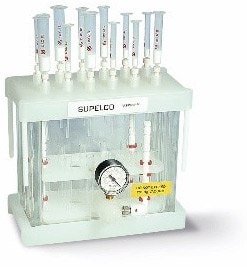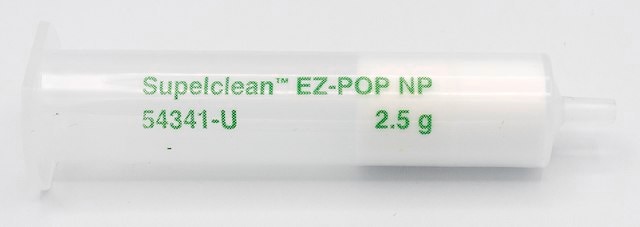Solid Phase Extraction (SPE)

Solid phase extraction (SPE) is a technique designed for rapid, selective sample preparation and purification prior to the chromatographic analysis (e.g. HPLC, GC, TLC). In SPE, one or more analytes from a liquid sample are isolated by extracting, partitioning, and/or adsorbing onto a solid stationary phase.
Featured Categories
Discover diverse materials for solid phase extraction (SPE) and QuEChERS sample prep. Cartridges, tubes, plates, and more available.
Achieve precise separations with our extensive HPLC column collection. Enhance retention, resolution, and selectivity. Order today.
Achieve superior GC performance with our columns, consumables, and accessories. Explore Supelco® offerings.
Solid phase extraction (SPE) is a technique designed for rapid, selective sample preparation and purification prior to the chromatographic analysis (e.g. HPLC, GC, TLC). In SPE, one or more analytes from a liquid sample are isolated by extracting, partitioning, and/or adsorbing onto a solid stationary phase.
Sample preparation by SPE changes the original matrix of a sample to a simpler matrix environment. This renders the sample more suitable for subsequent analytical chromatography, often simplifying and improving the final qualitative and quantitative analysis. The simpler sample matrix also lessons the demand placed on an analytical system, potentially extending the system’s lifetime.
An optimal SPE procedure can allow you to:
- Switch sample matrices to be more compatible with the target chromatographic method.
- Concentrate analytes (trace enrichment) for increased sensitivity.
- Remove interferences that cause high background, misleading peaks, and/or poor sensitivity during chromatographic analysis.
- Protect the analytical column from contaminants.
- Automate the extraction process.
How does SPE work?
In SPE, the stationary phase (a sorbent or resin) binds either the analyte or impurity through strong but reversible interactions to reliably and rapidly extract the analyte of interest from a complex sample.
SPE is selective and versatile as many different sorbents and elution conditions are available for different analytes and matrices. Common SPE sorbents include:
- Silica-based
- Reversed phase (C18, C8, cyano, phenyl)
- Normal phase (silica, diol, NH2)
- Ion exchange (SAX, WCX, SCX)
- Carbon-based
- Polymer-based (various compositions, different functionalities)
- Others, for example Florisil® (magnesium silicate) or Alumina
- Mixed-bed: Combinations of nearly any of the above in sequential layers
Strategies for SPE
In ‘Bind‒Elute SPE’, the analyte of interest is captured by the sorbent and the matrix interferences pass through the cartridge. In ‘Interference Removal SPE’, the matrix interferences are captured on the sorbent and the analytes of interest pass through. Both HybridSPE and QuEChERS SPE methods work via Interference Removal.
The optimal SPE method depends on the analyte’s structure, solubility, polarity and lipophilic properties (distribution coefficients). Selection guides are available to help choose the most favorable stationary phase and solvent for the application of interest.
Common applications of SPE
SPE is frequently used in the pharmaceutical, clinical and high-throughput diagnostic testing, forensic, environmental, and food/agrochemical industries for analyses related to:
- Pharmaceutical compounds and metabolites in biological fluids
- Drugs of abuse in biological fluids
- Environmental pollutants in drinking and wastewater
- Pesticides, antibiotics or mycotoxins in food/agricultural matrices
- Desalting of proteins and peptides
- Fractionation of lipids
- Water- and fat-soluble vitamins
Visit our document search for data sheets, certificates and technical documentation.
Related Articles
- Carbonyl compounds react within the DNPH cartridge to form immobilized hydrazones, which can be subjected to automated desorption and HPLC analysis with UV detection.
- HS-SPME with Carboxen®/PDMS coated Nitinol fiber allows low MW analyte detection in light-exposed milk plastics.
- 2-layer SPE cartridge efficiently reduces background for ginger contaminant analysis.
- Pistachios 45% fat complicates pesticide analysis. But Z-Sep+ sorbent cleanup after QuEChERS extraction can reduce background for reliable results.
- This Sigma-Aldrich article discusses how the HybridSPE-Phospholipid Technology works and how the phospholipids are removed.
- See All (38)
Related Protocols
- Fast, high-resolution separations of procainamide labeled glycans - dextran ladder, human IgG and cetuximab
- In this study, optimized methods are presented for sample preparation and chiral chromatography for the LC/MS analysis of amphetamine and methamphetamine enantiomers in urine.
- Optimized sample prep and chiral chromatography methods for the LC/MS analysis of these drug enantiomers in urine
- Optimize β-glucuronidase hydrolysis for glucuronide metabolite analysis considering factors like time, temperature, pH, and enzyme concentration.
- Acrylamide analysis has been a very hot topic since the chemical was identified in food in 2002 by researchers at the Swedish National Food Administration.
- See All (33)
Find More Articles and Protocols
How Can We Help
In case of any questions, please submit a customer support request
or talk to our customer service team:
Email [email protected]
or call +1 (800) 244-1173
Additional Support
- Chromatogram Search
Use the Chromatogram Search to identify unknown compounds in your sample.
- Calculators & Apps
Web Toolbox - science research tools and resources for analytical chemistry, life science, chemical synthesis and materials science.
- Customer Support Request
Customer support including help with orders, products, accounts, and website technical issues.
- FAQ
Explore our Frequently Asked Questions for answers to commonly asked questions about our products and services.
To continue reading please sign in or create an account.
Don't Have An Account?






















